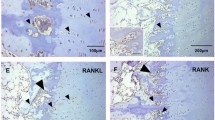Abstract
The development of cartilage canals is the first event of the ossification of the epiphyses in mammals. Canal formation differs from vascular invasion during primary ossification, since the former involves resorption of resting cartilage and is uncoupled from bone deposition. To learn more about the fate of resorbed chondrocytes during this process, we have carried out structural, cell proliferation, and in situ hybridization studies during the first stages of ossification of the rat tibial proximal epiphysis. Results concerning the formation of the cartilage canals implied the release of resting chondrocytes from the cartilage matrix to the canal cavity. Released chondrocytes had a well-preserved structure, expressed type-II collagen, and maintained the capacity to divide. All these data suggested that chondrocytes released into the canals remained viable for a specific time. Analysis of the proliferative activity at different regions of the cartilage canals showed that the percentage of proliferative chondrocytes at areas of active cartilage resorption was significantly higher than that in zones of low resorption. These results are consistent with the hypothesis that resting chondrocytes surrounding canals have a role in supplying cells for the development of the secondary ossification center. Since released chondrocytes are at an early stage of differentiation greatly preceding their entry into the apoptotic pathway and are exposed to a specific matrix, cellular, and humoral microenvironment, they might differentiate to other cell types and contribute to the ossification of the epiphysis.


Similar content being viewed by others
References
Apte SS, Seldin MF, Hayashi M, Olsen BR (1992) Cloning of the human and mouse type-X collagen genes and mapping of the mouse type-X collagen gene to chromosome 10. Eur J Biochem 206:217–224
Cancedda R, Descalzi Cancedda F, Castagnola P (1995) Chondrocyte differentiation. Int Rev Cytol 159:265–358
Cole AA, Cole AM Jr (1989) Are perivascular cells in cartilage canals chondrocytes? J Anat 165:1–8
Cole AA, Wezeman FH (1985) Perivascular cells in cartilage canals of the developing mouse epiphysis. Am J Anat 174:119–129
Descalzi Cancedda F, Gentili C, Manduca P, Cancedda R (1992) Hypertrophic chondrocytes undergo further differentiation in culture. J Cell Biol 117:427–435
Ganey TM, Love SM, Ogden JA (1992) Development of vascularization in the chondroepiphysis of the rabbit. J Orthop Res 10:496–510
Gentili C, Bianco P, Neri M, Malpeli M, Campanile G, Castagnola P, Cancedda R, Cancedda FD (1993) Cell proliferation, extracellular matrix mineralization, and ovotransferrin transient expression during in vitro differentiation of chick hypertrophic chondrocytes into osteoblast-like cells. J Cell Biol 122:703–712
Holmbeck K, Bianco P, Caterina J, Yamada S, Kromer M, Kuznetsov SA, Mankani M, Robey PG, Poole AR, Pidoux I, Ward JM, Birkedal-Hansen H (1999) MT1-MMP-deficient mice develop dwarfism, osteopenia, arthritis, and connective tissue disease due to inadequate collagen turnover. Cell 99:81–92
Kohno K, Martin GR, Yamada Y (1984) Isolation and characterization of a cDNA clone for the amino-terminal portion of the pro-alpha 1(II) chain of cartilage collagen. J Biol Chem 259:13668–13673
Lee ER, Lamplugh L, Davoli MA, Beauchemin A, Chan K, Mort JS, Leblond CP (2001) Enzymes active in the areas undergoing cartilage resorption during the development of the secondary ossification center in the tibiae of rats aged 0–21 days. I. Two groups of proteinases cleave the core protein of aggrecan. Dev Dyn 222:52–70
Olsen BR, Reginato AM, Wang W (2000) Bone development. Annu Rev Cell Dev Biol 16:191–220
Pelton RW, Dickinson ME, Moses HL, Hogan BL (1990) In situ hybridization analysis of TGF beta 3 RNA expression during mouse development: comparative studies with TGF beta 1 and beta 2. Development 110:609–620
Riminucci M, Bradbeer JN, Corsi A, Gentili C, Descalzi F, Cancedda R, Bianco P (1998) Vis-a-vis cells and the priming of bone formation. J Bone Miner Res 13:1852–1861
Rivas R, Shapiro F (2002) Structural stages in the development of the long bones and epiphyses: a study in the New Zealand white rabbit. J Bone Joint Surg Am 84A:85–100
Roach HI (1997) New aspects of endochondral ossification in the chick: chondrocyte apoptosis, bone formation by former chondrocytes, and acid phosphatase activity in the endochondral bone matrix. J Bone Miner Res 12:795–805
Roach HI, Clarke NM (1999) “Cell paralysis” as an intermediate stage in the programmed cell death of epiphyseal chondrocytes during development. J Bone Miner Res 14:1367–1378
Roach HI, Shearer JR (1989) Cartilage resorption and endochondral bone formation during the development of long bones in chick embryos. Bone Miner 6:289–309
Roach HI, Erenpreisa J, Aigner T (1995) Osteogenic differentiation of hypertrophic chondrocytes involves asymmetric cell divisions and apoptosis. J Cell Biol 131:483–494
Roach HI, Baker JE, Clarke NM (1998) Initiation of the bony epiphysis in long bones: chronology of interactions between the vascular system and the chondrocytes. J Bone Miner Res 13:950–961
Roach HI, Mehta G, Oreffo RO, Clarke NM, Cooper C (2003) Temporal analysis of rat growth plates: cessation of growth with age despite presence of a physis. J Histochem Cytochem 51:373–383
Scammell BE, Roach HI (1996) A new role for the chondrocyte in fracture repair: endochondral ossification includes direct bone formation by former chondrocytes. J Bone Miner Res 11:737–745
Suda T, Takahashi N, Martin TJ (1992) Modulation of osteoclast differentiation. Endocr Rev 13:66–80
Wilsman NJ, Van Sickle DC (1972) Cartilage canals, their morphology and distribution. Anat Rec 173:79–93
Acknowledgements
We thank Maria Quintana for assistance in the laboratory.
Author information
Authors and Affiliations
Corresponding author
Additional information
This research was supported by the Ministerio de Ciencia y Tecnología (Spain), grant no. MCT-00-BMC-0446. The Instituto Universitario de Oncología is financed by Obra Social Cajastur-Asturias, Spain. J. Alvarez receives financial support from the Ministerio de Ciencia y Tecnología (CAJAL-03-06) and L. Costales from the Ministerio de Ciencia y Tecnología (MCYT, FP2000-5486).
Rights and permissions
About this article
Cite this article
Álvarez, J., Costales, L., López-Muñiz, A. et al. Chondrocytes are released as viable cells during cartilage resorption associated with the formation of intrachondral canals in the rat tibial epiphysis. Cell Tissue Res 320, 501–507 (2005). https://doi.org/10.1007/s00441-004-1034-z
Received:
Accepted:
Published:
Issue Date:
DOI: https://doi.org/10.1007/s00441-004-1034-z




